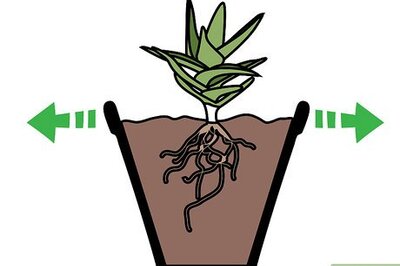
views
The Centre on Friday announced that Tata Sons has been selected as the winning bidder to take over state-run carrier Air India, marking the end of years of struggle to privatise the financially troubled airline. Tata Sons, the holding company for the autos-to-steel Tata conglomerate, bid 180 billion rupees ($2.40 billion) for the government’s 100 per cent stake in Air India, said Tuhin Kanta Pandey, Secretary to the Department of Investment and Public Asset Management (DIPAM).
It is a journey marked by highs and lows as the airline that took India to the world (and brought the world to India) could find no takers for the longest time as it bled the national exchequer and ran into rough weather on everything from management to finances.
WHY IS THE GOVT SELLING AIR INDIA?
It was the third attempt to sell the national carrier and this time the Centre went all out, deciding to offload its entire stake lock, stock and barrel to the highest bidder.
ALSO READ; Air India Returns to Tata House after 68 Years; A Timeline of Air India Privatisation
“We’ve decided that Air India will be 100 per cent disinvested. Choice isn’t between disinvestment and non-disinvestment, it’s between disinvestment and closing down," Union Minister Hardeep Singh Puri had said in March this year.
The airline remains a “first-rate asset" but there is a need to wipe the “slate clean" since it is now buckling under a cumulative debt of Rs 60,000 crore, the minister had said.
The story of AI’s sale has witnessed several twists and turns since such a move was first put together in 2000. “There is no choice, we either privatise or we close the airline. We run a loss of Rs 20 crore every day despite Air India making money now. Because the mismanagement has resulted in a cumulative debt of Rs 60,000 crore," Puri said.
The Narendra Modi-led government had attempted in 2017, too, to sell the airline, but reports suggest that its decision then to hold on to 24 per cent stake had led to no buyers coming forward. Before that, the NDA government led by Atal Bihari Vajpayee had in 2001 decided to sell 40 per cent stake in the airline. But while several major players are said to have shown an interest, the stake sale didn’t eventually materialise.
WHAT DOES THE LATEST OFFER INVOLVE?
The government is divesting its 100 per cent ownership of Air India and Air India Express along with its 50 per cent stake in ground-handling company AISATS. The bids were invited on the enterprise value of the company, which includes short-term and long-term debt as well as any cash on the company’s balance sheet.
ALSO READ: Air India: Acquisition is the Easiest Part, Real Work for the Tatas Starts Now
According to reports, Air India will pass into the hands of its prospective owner with a debt of Rs 23,000 crore. The remaining debt of the company will be taken up by the government-owned Air India Asset Holdings Ltd (AIAHL) — which is a new entity that will hold the carrier’s assets, such as the Air India building in Mumbai, Airlines House in Delhi, etc.
But the deal for the airline is not all about tallying losses since the buyer will at once get access to the enormous infrastructure owned by Air India along with the tremendous cachet it enjoys for being India’s premier international carrier. That should instantly propel its new owners into the league of aviation royalty.
Control over Air India will automatically bring control of 4,400 domestic and 1,800 international landing and parking slots at domestic airports, as well as 900 slots at airports overseas.
One of these international slots can cost millions of dollars while the real estate Air India owns in India alone runs into the hundreds of crores. In a reply to Parliament earlier this year, the aviation ministry had said that the total value of Air India’s fixed assets — comprising its land and buildings, aircraft fleet, etc. — in March 2020 was more than Rs 45,000 crore.
HOW DID IT GET HERE?
The history of the airline is older than that of independent India and goes back to 1932 when JRD Tata, the first Indian to earn a pilot’s licence, decided to start an airmail service between Karachi and Bombay. He would soon expand services and, after World War II, launch passenger operations in 1948.
Even after the Indian government decided to nationalise the airline in 1953, JRD Tata remained at its helm, discharging a labour of love and ensuring the airline continued to give the best international carriers a run for their money. He would eventually be pushed out in 1978 due to differences with the Morarji Desai-led Janata Party government, though Indira Gandhi would later bring back, putting him on the Air India board.
Experts say that its present problems can be traced back to 2007, when the then UPA government effected a merger of Air India and Indian Airlines and placed a huge order for aircraft, which saw the airline’s debt swell to tens of thousands of crores. By then, the domestic aviation sector had undergone a transformation but Air India could not capitalise on the opportunity and saw the likes of Jet, IndiGo and other new entrants capture plum shares of the Indian aviation pie.
WHAT IS THE AIR INDIA LEGACY?
At a time when the world was far less connected than it is now, Air India gave wings to India’s global aspirations and proved to be an iconic ambassador for the country’s culture. It opened offices in prime locations across the major capitals and built its brand on Indian art and aesthetics to woo foreign patrons. In the process, it also came to become one of the biggest collectors of Indian art. Works by MF Hussain, VS Gaitonde, Anjolie Ela Menon, to name just a few, are still a part of its enviable inventory.
Its efforts to create a unique brand saw Air India executives also convince Salvador Dali to design an ashtray, about 250 pieces of which were given as a gift to its first-class flyers. Such was the lengths to which the airline was permitted to go that a baby elephant, reportedly with a mahout in tow, was dispatched to Spain at the painter’s request. The pachyderm is said to have ended up eventually at a zoo.
But nothing captures the emotional connect Air India holds for entire generations of Indians than the ‘Maharajah’ mascot. Conceived by Bobby Kooka, Air India’s Commercial Director and created in collaboration with artist Umesh Rao, the Maharajah made his first appearance in 1946. He soon came to symbolise Indian hospitality, taking “Air India’s sales and promotional messages to millions of travellers across the world".
The airline also has a few firsts and records to its name. In 2017, it said it had become the first airline to fly around the world with an all-woman crew. In 1990, it entered the Guinness World Record for the largest evacuation conducted by a civil airline, operating more than 450 flights in 59 days to airlift over 1 lakh Indians from Kuwait during the Iraq War.
Going private also raises the question of where the government will now turn when a need arises to evacuate Indians at short notice. And what about the aircraft for the user of dignitaries like the President and PM?
Read all the Latest News , Breaking News and IPL 2022 Live Updates here.



















Comments
0 comment